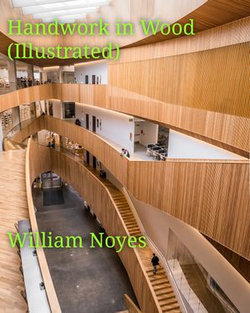Handwork in Wood (Illustrated)
Author: William Noyes
Copyright Status: Public Domain
Category:Technology: Handicrafts, Arts and crafts, Woodwork Carving Crafts
Table of Contents
HANDWORK IN WOOD
Teachers College, Columbia University
WILLIAM NOYES 1910
FOREWORD
CONTENTS.
GENERAL BIBLIOGRAPHY
Chapter I.
LOGGING.
MECHANICAL METHODS IN LUMBERING.
LOGGING.
Chapter II.
SAWMILLING.
SAWMILLING.
Chapter III.
SEASONING.
PRACTICAL SUGGESTIONS FOR STORING LUMBER.
WOOD MEASUREMENTS.
THE SEASONING AND MEASURING OF WOOD.
Chapter IV.
WOOD HAND TOOLS.
- CUTTING TOOLS.
SAWS.
PLANES. - BORING TOOLS.
- CHOPPING TOOLS.
WOOD HAND TOOLS.
Chapter IV, Continued.
WOOD HAND TOOLS. - SCRAPING TOOLS.
- POUNDING TOOLS.
- HOLDING TOOLS. A. Tools for Holding Work.
B. Tools for holding other tools. - MEASURING AND MARKING TOOLS.
- SHARPENING TOOLS.
- CLEANING TOOLS.
WOOD HAND TOOLS.—Continued.
Chapter V.
WOOD FASTENINGS.
NAILS
SCREWS
BOLTS
GLUE
HINGES
HINGING
LOCKS
INSERTING LOCKS
WOOD FASTENINGS
Chapter VI.
EQUIPMENT AND CARE OF THE SHOP.
$400 TOOL EQUIPMENT. INDIVIDUAL TOOLS.
GENERAL TOOLS
$750 TOOL EQUIPMENT
GENERAL TOOLS
METALWORKING TOOLS
THE CARE OF THE WOODWORKING SHOP
EQUIPMENT AND CARE OF THE SHOP
CHAPTER VII.
THE COMMON JOINTS.
HEADING JOINTS
BUTT JOINTS
HALVING-JOINTS
MODIFIED HALVING JOINTS
MORTISE-AND-TENON JOINTS
DOVETAIL JOINTS
BEVELED JOINTS
THE COMMON JOINTS
Chapter VIII.
TYPES OF WOODEN STRUCTURES.
(1) SIMPLE OR UNJOINED PIECES
(2) BOARD STRUCTURES.
(3) PANEL STRUCTURES
(4) FRAMED STRUCTURES
TYPES OF WOODEN STRUCTURES
Chapter IX.
PRINCIPLES OF JOINERY.11
THE PRINCIPLES OF JOINERY
Chapter X.
WOOD FINISHING.
STAINS.
FILLING
POLISHES
PAINTING
TOOLS AND MATERIALS FOR WOOD FINISHING
WOOD FINISHING
INDEX.
Transcriber's Note:
This book was originally published prior to 1923 and represents a reproduction of important historical work, maintaining the same format as the original work. While some publishers have opted to apply OCR (optical character recognition) technology to the process, we believe this leads to sub-optimal results (frequent typographical errors, strange characters, and confusing formatting) and does not adequately preserve the historical character of the original artifact. We believe this work is culturally important in its original archival form. While we strive to adequately clean and digitally enhance the original work, there are occasionally instances where imperfections such as blurred or missing pages, poor pictures or errant marks may have been introduced due to either the quality of the original work or the scanning process itself. Despite these occasional imperfections, we have brought it back into print as part of our ongoing global book preservation commitment, providing customers with access to the best possible historical reprints. We appreciate your understanding of these occasional imperfections, and sincerely hope you enjoy seeing the book in a format as close as possible to that intended by the original publisher.
This book is intended primarily for teachers of woodwork, but the author hopes that there will also be other workers in wood, professional and amateur, who will find in it a matter of interest and profit.
The successful completion of the book is due chiefly to the untiring assistance of my wife, Anna Gausmann Noyes, who has made almost all of the drawings, corrected the text, read the proof, and attended to numberless details.
Acknowledgments are hereby thankfully given for corrections and suggestions in the text made by the following persons:
Mr. Chas. W. Weick of Teachers College, and Mr. W. F. Vroom of Public School No. 5, of New York City, for revision of Chapters IV and V on tools and fastenings.
Mr. Clinton S. VanDeusen of Bradley Polytechnic Institute, for revision of Chapter X on wood finishing.
The Forest Service, Washington, D. C. for the originals of Figs. 1, 2, 3, 5, 7, 8, 9, 10, 11, 13, 17, 18, 21, 22, 23, 24, 26, 27, 28, 29, 31, 33, and 54.
The New York State Forest Fish and Game Commission for the originals of Figs. 12, 14, 15, and 47.
T. H. McAllister of New York for the originals of Figs. 16 and 20.
The Detroit Publishing Company for the original of Fig. 6.
The B. F. Sturtevant Company, Hyde Park, Mass., for the original of Fig. 57.
Doubleday, Page & Co. for the original of Fig. 30.
Mr. Louis A. Bacon, Indianapolis. Ind., for the clamping device shown in Fig. 255.
Sargent & Company, New Haven, Conn., W. C. Toles & Company, Chicago, Ill., The Berlin Machine Works, Beloit, Wis., A. A. Loetscher, Dubuque, Iowa, and the Stanley Rule and Level Co., New Britain, Conn., for electrotypes.
Allis Chalmers Company, Milwaukee, Wis., Clark Brothers, Belmont, N. Y., The M. Garland Company, Bay City, Mich., The Prescott Company, Menominee, Mich., for illustrations of sawmilling machinery.
And most of all, I wish to acknowledge my obligation to the numerous writers of whose books and articles I have made free use, to which references are made in the appropriate places. Source; Wikipedia



Share This eBook: